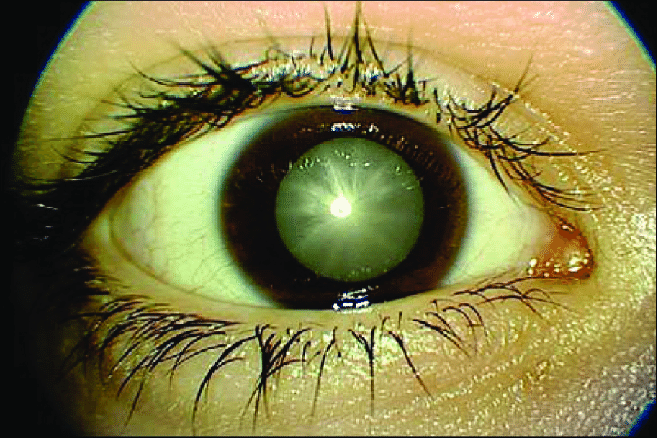A PPC cataract is a clouding of the eye’s natural lens. The lens is located behind the iris (the colored part of the eye) and the pupil (the black center of the eye). The lens helps focus light onto the retina, which is the back of the eye where images are formed. When a cataract forms, it affects how light passes through the lens and can cause blurry or dim vision. Cataracts usually develop slowly and can affect people at any age, but they are most common in adults over age 60. In this blog, read everything about PPC cataracts including their signs, causes, and treatment.
What is PPC Cataract?

PPC, or posterior polar cataract, is a type of cataract that forms at the back of the lens. This type of cataract is usually found in people over the age of 60 and is caused by changes in the proteins in the lens. PPC can also be caused by certain medical conditions, such as diabetes, that cause changes in the proteins.
This type of cataract is also sometimes called a nuclear cataract. The development of this disorder is age-related and is more common in women. Treatment includes the use of intraocular lenses, which are implanted during surgery to help correct vision.
Sometimes, people with PPC may not be aware that they have a cataract because vision loss is gradual. However, symptoms can include blurry vision, difficulty seeing at night, and the need for more light when reading. If the cataract is left untreated, it can eventually lead to complete blindness.
What are the Symptoms of PPC Cataracts?
PPC cataracts typically develop slowly and may not cause any symptoms in the early stages. As the cataract progresses, symptoms may include:
Blurry Vision
One of the most common symptoms of a cataract is blurry vision. This can be especially noticeable when reading or trying to see small objects. Patients may also experience difficulty driving at night, as vision problems caused by a cataract can make it difficult to see when there is not much light.
Glare
Another symptom associated with PPC cataracts is glare, which can make it difficult to read or drive on bright days or in direct sunlight. Patients may also find that they are sensitive to bright lights and have trouble seeing clearly when they are in dimly lit rooms.
Double Vision
PPC cataracts may cause double vision if the cataract forms in both eyes. This can be a very debilitating symptom, and patients will often seek treatment for this problem before any other symptoms develop related to the cataract. Double vision also has the potential to cause headaches, dizziness, and nausea.
Colors Appearing Faded or Less Bright
An advanced PPC cataract may cause the colors in a patient’s vision to appear faded or less bright. This can make it difficult to distinguish between different colors, and it may also make it more challenging for patients to read signs or see the contrast.
Difficulty Seeing at Night
Sometimes, PPC cataracts can cause difficulty seeing at night. This is because the pupil of the eye becomes less responsive to changes in light, making it difficult to see clearly when there is not much light. Patients with this symptom may also experience difficulty driving at night or in dimly lit rooms.
Reasons For PPC Cataracts

The most common cause of posterior polar cataracts is age. As people get older, their lenses can become more opaque and develop a cataract. Other causes of posterior polar cataracts include:
Diabetes
One of the most common risk factors for cataracts is diabetes. People with diabetes are more likely to develop cataracts at a younger age. Sometimes, cataracts can be the first sign of diabetes.
Hypertension
High blood pressure is another risk factor for posterior polar cataracts. People with hypertension are more likely to develop this type of cataract.
Prolonged exposure to UV light
People who spend a lot of time in the sun or who have jobs that require them to be exposed to UV light (such as welders) are at a higher risk for developing posterior polar cataracts.
Smoking
Smokers are also at a higher risk of developing posterior polar cataracts. Tobacco smoke contains many harmful toxins that can damage the eye and lead to cataracts.
Certain Medications
Certain medications, such as steroids, can increase the risk of cataracts.
Previous eye surgery
People who have had previous eye surgery are more likely to develop posterior polar cataracts.
Trauma
Eye trauma can also lead to the development of posterior polar cataracts.
How is PPC Cataract Diagnosed?
PPC cataracts are diagnosed during a comprehensive eye exam with an experienced eye doctor. During this exam, your doctor will check your vision and look for any evidence of a cataract. Your eye doctor may also perform tests that can measure the density of the cataract and help determine how much it has affected your vision. In some cases, your doctor may recommend that you have an MRI or CT scan to get a better look at the structure of the eye and identify any other problems that could be causing your symptoms.
PPC cataract is diagnosed in a few ways. The first is through a comprehensive eye examination which includes visual acuity testing, intraocular pressure assessment, and examinations of the front and back of the eye. Your ophthalmologist will also look for any signs of PPC cataract development during this examination.
The second way PPC cataracts can be diagnosed is through advanced imaging tests such as ultrasound or OCT (optical coherence tomography). These tests can help to identify the presence of PPC cataracts even before they cause any symptoms or vision changes.
What Are The Treatment Options for PPC Cataracts?

PPC cataract is a type of cataract that affects the back of the eye’s lens. It is caused by a buildup of proteins in the lens, which can cause vision problems.
There are several treatment options for PPC cataracts, including:
Medications
One of the most common treatments for PPC cataracts is using eyedrops or other medications to help control the protein buildup in the lens. These medications can help to improve vision and slow the progression of the cataract. Some of these medications are available over the counter, while others require a prescription from an eye doctor.
Surgery
In some cases, surgery may be necessary to remove the cataract. Surgery is usually performed on an outpatient basis and takes about an hour. Surgery is typically only considered when the cataract is causing severe vision problems that cannot be corrected with medication. Also, surgery may be recommended if the cataract is impacting your quality of life.
Laser surgery
Laser surgery is another option for treating PPC cataracts. This type of surgery uses a laser to break up the protein buildup in the lens. Laser surgery is usually performed on an outpatient basis and takes about 30 minutes. It is typically only considered when the cataract is causing severe vision problems that cannot be corrected with medication or surgery.
Prevention of PPC Cataract
One of the best ways to prevent posterior polar cataracts is by protecting your eyes from the sun. UV radiation can damage the lens and increase the risk of developing a posterior polar cataract. Make sure to wear sunglasses that provide UV protection when you are outdoors, and avoid spending too much time in the sun.
Another way to help prevent posterior polar cataracts is to eat a healthy diet. Foods that are high in antioxidants, such as fruits and vegetables, can help protect the lens from damage. It is also important to drink plenty of water since dehydration can increase your risk of developing a cataract.
Make sure to get regular eye exams. Early detection is key in preventing any type of cataract from developing. Sometimes, cataracts can be removed surgically before they cause any vision problems.
Try to avoid smoking. Smoking is a major risk factor for developing all types of cataracts, so quitting is one of the best things you can do for your eyesight.
By following these tips, you can help prevent posterior polar cataracts and keep your vision healthy.
Conclusion
Although a PPC cataract may seem daunting, with the right information and treatment, you can manage this condition effectively. We hope that this guide has given you a better understanding of what a PPC cataract is and how it can be treated. If you have any further questions, please don’t hesitate to reach out to your doctor or an eye specialist.
Cataract surgery is a safe and painless procedure. At EyeMantra we have a team of experienced eye surgeons, who will be happy to answer any questions on cataract surgery, cataract surgery cost, cataract lens cost for different cataract surgery types- Phacoemulsification, MICS & Femto Laser Cataract. Call us at +91-9711116605 or email at [email protected] for inquiries.


